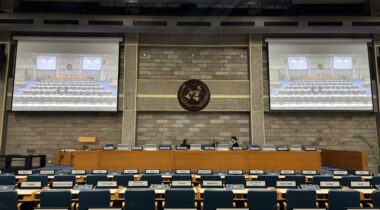Veronica Grondona ■ The dangers of the residual profit split

With the OECD tax reforms apparently converging towards a version of the residual profit split approach, new Tax Justice Network researcher and former advisor on transfer pricing for multinational companies Verónica Grondona explains the origins and risks of the approach.
The OECD and G20 Inclusive Framework on Base Erosion and Profit Shifting (BEPS) presented its “Programme of work to develop a consensus solution to the tax challenges arising from the digitalisation of the economy” on 20 June 2019.
In January 2019, the OECD and G20 had co-published a policy note on “Addressing the Tax Challenges of the Digitalization of the Economy”, which underlined that there was an agreement to examine proposals involving two pillars which could be the basis for consensus: the allocation of taxing rights and remaining BEPS issues.
What are the OECD and G20 proposing?
The more recent programme comes after launching a consultation and engaging in further negotiations between the countries participating in the OECD and G20 Inclusive framework.
In the chapter on pillar one, three proposals on which to build a consensus are mentioned:
- User participation
- Marketing intangibles
- Significant economic presence
As mentioned by the OECD itself, the three proposals “all allocate more taxing rights to the jurisdiction of the customer and/or user”, the market jurisdictions, something which already represents a problem for developing countries’ tax collection, as their contribution relies more on other factors such as employees and not normally in sales.
The programme also notes that “this work will consider the feasibility of business line or regional segmentations, different mechanisms to allocate the profit to the relevant market jurisdictions…”.
The segmentation by business line has been used by the Big Four and other medium tier consultants as part of their application of the arm’s length rules for the last 20 years, and goes in the opposite direction to unitary taxation, as it not only abides by the separate entity criteria, but it subdivides entities even further by segmenting their financial data not only by business segment, but also by type of transaction, as has been observed by Grondona in 2014.
The programme proposes 3 methods for the allocation of taxing rights: the modified residual profit split (MRPS), the fractional apportionment method, and the distribution-based approach.
The modified residual profit split: new tires, same old car
The modified residual profit split is a re-launch of the ‘residual profit split’, a well-known method that has been used for years and had already been incorporated to several legislations by 2012, eg Colombia, Ecuador, Mexico, Peru, Japan and the United States, as noted by PwC.
As described by PwC, in such applications of the residual profit split method, allocation is done by determining first the profit of routine activities using any of the other methods available and then allocating the residual profit in proportion to the value of the intangible property and to what they contribute or own.
The programme describes that the options regarding the modified residual profit split are expected to include “the development of rules to bifurcate total profit into routine and non-routine Components”, and that this “would require an evaluation of the relative merits of using current transfer pricing rules and simplified approaches”, and adapting such transfer pricing rules to fit the new purpose under discussion.
On June 24, David Bradbury, Head of Tax Policy and Statistics Division at the OECD commented at the 2nd conference of the Parliamentary Platform on Tax Justice held in Paris, that the post-allocation and application of this to non-routine returns would be new, so the old and ‘new’ system would apply in parallel.
It may be accepted that the available options of the modified residual profit split are different from the old ones, but the differences seem quite thin, at least from what can be interpreted out of the alternatives described in the OECD’s programme.
The modified residual profit split privileges developed countries
What is the problem with the allocation of profits using the residual profit split?
The modified residual profit split in practice involves a segmentation of financial data per business segment and type of transaction. This results in routine profits generally being estimated based on the most popular method, which according to a CIAT study for Latin America, is the transactional net margin method (TNMM), which basically assigns a net profit to the activity by comparing its activities to a benchmark. For example, if a company in country X selling air tickets online is part of group A, then what would normally happen is that the financial accounts will be segmented in order to separate activities as follows: contract distribution for related parties, marketing activities for related parties, administrative services for related parties, etc. All these transactions would be considered “routine” and would be allocated a profit based on a benchmark with “contract” activities of similar type.
Since “contract distribution” involves few functions, risks and assets, such activities would be assigned a minimum profit. The related party which centralises such activities and has been “contractually” assigned the assets, risks and functions related to such transactions would keep all remaining profits. Justification is generally found for such centralisation of assets, risks and functions to take place in corporate tax havens.
The non-routine activities, those related to value creation, the main part of the profit attributable to the development of the intangible goods associated to the transaction, would then be allocated among the participating entities using an allocation formula. This approach privileges developed economies.
Thus, such way of estimating intragroup prices does not solve existing transfer pricing conflicts for both developed and developing countries, as tax administrations will bump into the same obstacles as they run into today when trying to use the arm’s length principle to estimate a multinational entity’s tax base.
It would still be possible, as things stand today, to contractually locate non-routine activities in the convenient countries. This would make the new measures redundant, leaving the door wide open for companies to shift both types of profit to corporate tax havens.
Dispute resolution is of course on the menu, something that does trigger some alarms in developing countries, because the rules are quite subjective as it is well described by the BEPS Monitoring Group.
Let’s be clear: the residual profit split is not a close substitute to unitary taxation with formulary apportionment. Therefore, the fight for a fairer international tax system has not finished. Alternatives are on the table, such as the one proposed by India and the G24 on the use of a fractional apportionment that should be paid attention to. Accepting an OECD proposal for residual profit split would risk delaying real progress beyond the current reform.
Related articles

Let’s make Elon Musk the world’s richest man this Christmas!

The tax justice stories that defined 2025

The best of times, the worst of times (please give generously!)

Admin Data for Tax Justice: A New Global Initiative Advancing the Use of Administrative Data for Tax Research

2025: The year tax justice became part of the world’s problem-solving infrastructure

Bled dry: The gendered impact of tax abuse, illicit financial flows and debt in Africa
Bled Dry: How tax abuse, illicit financial flows and debt affect women and girls in Africa
9 December 2025

Indicator deep dive: ‘patent box regimes’

Two negotiations, one crisis: COP30 and the UN tax convention must finally speak to each other


